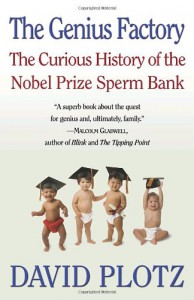Seriously, Read a Book!
Thoughts on books, often interpreted through the high-brow prism of cartoon (read: Archer) references. Wait! I had something for this...
Currently reading
The Genius Factory: The Curious History of the Nobel Prize Sperm Bank

Dutch optician/astronomer/naturalist, Nicolaas Hartsoeker's Essai de Dioptrique (1694) features one of my favorite illustrations in the history of science (sorry Vesalius, De Humani Corporis Fabrica might have to take a back seat for once). What could possibly oust the masterful engravings of volumes of infinitely greater consequence? The homunculus. For those of you who don't parlez français, you needn't fear- the picture (below) pretty much says it all.
Yes, Hartsoeker peered through the microscope and, seeing those squiggly little suckers below the lens, helped bring unto the world the panspermist theory of preformationism featuring tons of tiny, fully-formed humans ready to burst forth in every wad of *cough* semen.
Though Hartsoeker's vision had been cast aside long before the Repository for Germinal Choice (aka the Nobel Prize Sperm Bank) was conceived, the "spirit" of it (a little tiny sperm-person spirit) was (is?) alive and well when, in 1980, the bank was founded by Robert Klark Graham (seen below admiring a sample with such reverence). Sure we've fancied up the science a bit- tossed in some friar's pea plant and a helix or two, but Graham and co. churned up a consumer public who very much believed that the bits and pieces of a great human could be locked inside someone's "little swimmers."
The Bank's Beginnings and the Shock Factor
In all likelihood, you aren't familiar with Graham himself (though you have him to thank for shatterproof eyeglass lenses). However, you might have heard and most definitely have reaped the technological rewards of physicist, inventor, Nobel laureate and completely racist a**hole, William Shockley.
Yes, the transistor is a pretty big deal. and Shockley was one of the forefathers of Silicon Valley. He was one of the Repository's biggest champions and was certainly its biggest liability. Without getting into the nuances of scientific (mis)understanding of genetics at the time, let's just say that Shockley was the vocal proponent of every aspect of eugenics that makes people squirm. In a very Fred Phelps-esque way, Shockley basked in every bit of attention that came his way. When students were protesting outside his Stanford office and their megaphones broke, Shockley came out and fixed them before retreating to his den.
Genius Babies
Bad PR did not stop demand for the sperm of brilliance. Graham and co. (which consisted of a couple other oddball characters) couldn't court donors fast enough. And, to clarify, it was all about "courting" the donors. I'm going to skip the parts about just how far from the "Nobel Laureate" ideal the Repository had to stray, but nevertheless they were always looking for "good seed."Graham would literally take guys out to dinner, tell them about his project, then try to get them to go back to his hotel with him to "produce a sample" on the spot.
Author David Plotz' ongoing journey ("An Experiment in Long-Form Cyberjournalism" with the help of his employer, Slate) is a good chunk of the book. Personally, I didn't find the "genius babies" (all the children of married - or now divorced, white women) and donors uncovered to be all that interesting, but it's all in there. So, you know, read the book.
The Booming Sperm Sector
Though the Repository for Germinal choice did not, itself, produce all that many children, it did reveal a huge market for not just donated sperm, but information and choice about the donors (Sperm Banks are unlikely to make the walk-by donor ATM switch anytime soon). Is this a slippery slope towards Aldous Huxley's Brave New World? Probably not. However, the "industry" has embraced the inherent weirdness of it all with fervor.
Plotz, ever the good reporter, goes in deep- finding the process of becoming a donor to be a matter of intense vetting, and lots of kitsch (e.g. sperm mouse pads, and references to masterbatoriums). While the ATM might be a pipe dream, the delivery of spooge by sperm bike is not! (Lucky denizens of Copenhagen and Seattle can see them rolling down the streets already- more on that here).
How was the book?
It was fine. I'm glad I didn't pay for it (libraries are pretty awesome), and would likely have found Plotz' series of Slate articles sufficient to sate my curiosity (the "Seed" series link appears to be no more, but you can get started with "The 'Genius Babies,' and How They Grew".
 3
3
 2
2
















